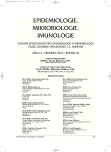Antibodies against the Causative Agents of Some Natural Focal Infections in Blood Donor Sera from Western Slovakia
Authors:
S. Bazovská; D. Guryčová; V. Výrosteková; J. Jareková; P. Bakoss; E. Macháčová; M. Špaleková
Authors‘ workplace:
Ústav epidemiológie Lekárskej fakulty UK v Bratislave
Published in:
Epidemiol. Mikrobiol. Imunol. 59, 2010, č. 4, s. 168-171
Overview
Objective:
Western Slovakia is known for the presence of natural foci of some infections. The long--term monitored foci of leptospirosis, tularaemia and Lyme borreliosis showed persisting activity, but cases of infection were reported only sporadically. To have a more accurate idea of the incidence of the monitored infections, blood donor sera from the afflicted areas were tested for antibodies against these infections.
Material and methods:
Sera of 302 blood donors from the Senec and Senica districts were tested for the presence of antibodies against Borrelia burgdorferi s. l. using a commercial Anti-Borrelia-plus-VlsE ELISA (IgG) Euroimmun kit, against Anapasma phagocytophilum using a Focus commercial IFA IgG kit, against leptospirae using a standard microagglutination test (MAT) and against Francisella tularensis using an agglutination test kit.
Results:
Antibodies against F. tularensis were detected in 4.01 % of the study subjects and those against leptospirae in 1 % of subjects. No case had been reported in the study subjects within the surveillance program of theses diseases. The detection of IgG antibodies against B. burgdorferi s. l. in as many as 8.6 % of the study subjects reflects frequent infections and that of IgG antibodies against A. phagocytophilum in 3.64 % of the study subjects documents the occurrence of this infection in western Slovakia.
Conclusions:
The detection of antibodies in blood donor sera indicates high exposure of the population to the causative agents of natural focal infections in western Slovakia despite the small numbers of reported cases. The levels of antibodies in the healthy population can be explained by the high variability of clinical manifestations of these infections or by a considerable proportion of asymptomatic cases. The relatively low number of reported cases may also be a result of diagnostic and/or reporting failure.
Key words:
antibodies against Francisella tularensis, Anaplasma phagocytophilum, Borrelia burgdorferi and leptospirae.
Sources
1. Arteaga, F., Coligtly, M. G., Perez, A. G et al. Disparity between serological reactivity and evidence of past disease in high-risk group. Clin. Infect. Dis., 1998, 27, p. 1210–1213.
2. Bakoss, P., Jareková, J. Prírodné ohniská leptospiróz na Slovensku v rokoch 1991–2007. Zborník Labudove dni 2009, 23.–24. apríla 2009, Bratislava, p. 69 –71.
3. Bakoss, P., Macháčová, E., Jareková, J. Výsledky surveillance humánnych leptospiróz. Slovensko 1986–2005. Epidem. Mikrobiol. Immunol., 2007, 56, 3, p. 140–149.
4. Bazovská, S., Macháčová, E., Špaleková, M., Kontrošová, S. Reported incidence of Lyme disease in Slovakia and antibodies to B. burgdorferi antigens detected in healthy population. Bratisl. Lek. Listy, 2005, 106, 8–9, p. 270–273.
5. Cizman, M., Avsic-Zupanc, T., Petrovec, M. et al. Seroprevalence of ehrlichiosis, lyme borreliosis and tick-borne encephalitis infections in children and young adults in Slovenia. Wien Klin. Wochenschr, 2000, 112, 19, p. 842–845.
6. Derdaková, M., Halanová, M., Stanko, M. et al. Molecular evidence for Anaplasma phagocytophila and Borrelia burgdorferi sensu lato in Ixodes ricinus tick from eastern Slovakia. Ann. Agric. Environ. Med., 2003, 10, p. 269–271.
7. Grzsezcuk, A. Anaplasma phagocytophilum in Ixodes ricinus ticks and human granulocytic anaplasmosis seroprevalence among rangers in Bialystok region. Adv. Med. Sci., 2006, 51, p. 283–286.
8. Guryčová, D., Tináková, K., Výrosteková, V., Gacíková, E. Výskyt tularémie na Slovensku v rokoch 1987–2008. Epidem. Mikrobiol. Imunol., 2010, 59, 1, p. 60–65.
9. Hulínská, D., Kurzová, Z., Dřevova, H. Votýpka, J. První poznatky o ehrlichióze, prokázané sérologicky a polymerázovou řetezovou reakcií u pacientov s boreliózou v České republice. Čas. Lék. čes., 2001, 140, 6, p. 181–184.
10. Loebermann, M., Fingerle, V., Lademann, M. et al. Borrelia burgdorferi and Anaplasma phagocytophilum Coinfection. Emerg. Infect. Dis., 2006, 112, 2, p. 353–355.
11. Stańczak, J., Grzseszuk, A. Seroprevalence of Anaplasma phagocytophilum among forestry rangers in northern and northeastern Poland. Ann. N. Y. Acad. Sci., 2006, 1078, p. 89–91.
12. Špitálska, E., Kocianová, E. Tick-borne microorganisms in southwestern Slovakia. Ann. N. Y. Acad. Sci., 2003, 990, p. 196–200.
13. Výrosteková, V., Guryčová, D. Dlhodobé sledovanie prírodného ohniska tularémie na juhozápadnom Slovensku. Zborník Labudove dni 2009, 23.-24. apríla 2009, Bratislava, p. 73 .
14. Výrosteková, V., Kocianová, E., Pertináčová, J., Truska, P. Ukazovatele rizika lymskej boreliózy v sledovanej oblasti Bratislavského kraja. Zborník X. Aktuálne problémy humánnej parazitoĺógie. Bratislava 2003, p. 56–58.
Labels
Hygiene and epidemiology Medical virology Clinical microbiologyArticle was published in
Epidemiology, Microbiology, Immunology

2010 Issue 4
Most read in this issue
- Leptospirosis in the Czech Republic and Potential for Laboratory Diagnosis
- Colistin in the treatment of severely burned patients infected by multiresistant strains of Pseudomonas aeruginosa
- Lipophilic Yeasts of the Genus Malassezia and Skin Diseases.II. Atopic Dermatitis
- Sporicidal Agents Highly Effective in Inactivating Bacillus anthracis Spores
